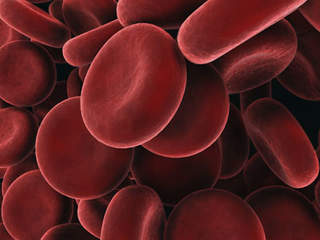Anemia

Anemia
Introduction
Anemia is a blood disorder characterized by a lack of red blood cells or hemoglobin, a substance in red blood cells. Anemia results if not enough normal hemoglobin or red blood cells are produced, too many red blood cells are destroyed, or if too much blood is lost. There are many types and several causes of anemia.
Symptoms of anemia include shortness of breath, fatigue, and a pale complexion. Treatment depends on the type and cause of anemia. Untreated anemia can lead to serious medical complications, such as a heart attack.
Anatomy
Your body needs oxygen to live. When you breathe in, your lungs absorb oxygen from the air. The oxygen attaches to hemoglobin, a component of your red blood cells. Your red blood cells travel throughout your body and deliver oxygen to all of your cells.
Red blood cells produced inside of your bones in the bone marrow live for about 120 days. Your bone marrow continually makes new red blood cells to replenish your supply.
Causes
Anemia is a medical condition that occurs when a person does not have enough red blood cells or enough hemoglobin. There are many causes and types of anemia. Anemia results if not enough normal red blood cells are produced or if too many red blood cells are destroyed. Anemia also occurs if too many red blood cells are lost due to excessive bleeding.
A lack of hemoglobin may result if there is not enough iron, folate, or vitamin B12 in a person’s diet. These nutrients are necessary for hemoglobin and red blood cell production. Some people may not produce enough red blood cells because of medical conditions that affect the bone marrow, such as certain infections, chronic illness, kidney disease, and arthritis. Certain medications may suppress the bone marrow's production of red blood cells or trigger destruction of red blood cells in the bloodstream. In rare cases, people are born with the inability to produce enough red blood cells.
Normally, red blood cells are round and flat. Genetic conditions, such as sickle cell anemia, can change the shape of a red blood cell and cause its destruction. Certain medications, infections, and chronic diseases can also change the shape of red blood cells.
The bone marrow may not be able to produce and replace red blood cells fast enough if a large amount of blood is lost due to bleeding. Substantial blood loss can result from serious traumatic accidents or from complications from surgery or childbirth. Anemia can result if a small amount of blood is lost over a long period of time. This may occur in females with heavy menstrual periods and people with inflammatory bowel disease or colon cancer.
Symptoms
Anemia can make you feel very tired. Your skin may look pale. You may experience shortness of breath or angina (heart-related) chest pain.
Diagnosis
Your doctor can diagnose anemia by reviewing your medical history, conducting a physical examination, and testing your blood. Your blood will be analyzed to determine the number of red blood cells, the amount of hemoglobin, and the size and shape of the red blood cells. Your doctor may order other tests depending on the type of anemia that you have.
Treatment
Treatment will depend on the cause and type of your anemia. Your doctor will treat the underlying cause of your condition, if possible. Your doctor may prescribe medication to help your bone marrow produce red blood cells. Your doctor may recommend vitamin and mineral supplements and a diet rich in such substances. A blood transfusion may be necessary for people with severe anemia.
Prevention
You may be able to prevent anemia by receiving prompt medical attention for prolonged or heavy bleeding from colon conditions or heavy menstrual bleeding in females. It may help to eat a diet that includes foods containing iron, folate, and vitamin B12. Iron is found in meat, dried beans, and leafy green vegetables. Folate is contained in citrus fruits, green vegetables, and fortified cereals. Meat, eggs, and dairy products are sources of vitamin B12. Your doctor may refer you to a nutritionist that can help you select products and plan meals based on your nutrition needs.
Am I at Risk
Risk factors may increase your likelihood of developing anemia, although some people that develop the condition do not have any risk factors. People with all of the risk factors may never develop the disease; however, the chance of developing anemia increases with the more risk factors you have. You should tell your doctor about your risk factors and discuss your concerns.
Risk factors for anemia:
_____ You may be at risk for anemia if you have an iron, folate, or vitamin B12 deficiency.
_____ Some anemia related blood diseases may be inherited. If your parents experienced or genetically carry a blood condition, you should talk to your doctor about your risk.
_____ Your risk for anemia is higher if you have medical conditions that affect your bone marrow, such as chronic illness, kidney disease, or arthritis.
_____ Significant blood loss from an injury or surgery can increase your risk for anemia.
_____ Females with heavy menstrual periods are at risk for anemia.
_____ Bleeding associated with inflammatory bowel disease or colon cancer increases the risk of anemia.
_____ Older adults and pregnant females have an increased risk for anemia.
_____ Certain medications may increase your risk for developing anemia, especially chemotherapies.
Complications
Severe anemia can lower the oxygen levels in blood. Low oxygen levels can lead to fatigue, shortness of breath, or even a heart attack. If you have low oxygen levels in your blood, your doctor should carefully monitor you. You may need to use supplemental oxygen.